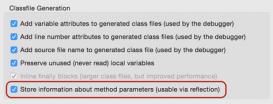大多数网站会设置用户权限,如过滤非法用户,用户不登录时不能进行访问,或者设置访问的权限,如部分内容仅对VIP开放等等,这些权限的控制都可以用struts2中的拦截器来实现。
下面通过一个简单的Demo来模拟这种用户权限控制的实现流程,设定三种不同身份的用户,commen为普通用户,VIP为会员用户,还有一种admin为管理员。
先看一下Demo的整体结构:

首先搭建struts2框架的开发环境(前面博客中有介绍),环境搭建完之后又再看一看如何配置struts.xml:
|
1
2
3
4
5
6
7
8
9
10
11
12
13
14
15
16
17
18
19
20
21
22
23
24
25
26
27
28
29
30
31
32
33
34
35
|
<?xml version="1.0" encoding="UTF-8" ?> <!DOCTYPE struts PUBLIC "-//Apache Software Foundation//DTD Struts Configuration 2.3//EN" "http://struts.apache.org/dtds/struts-2.3.dtd"> <struts> <package name="hello" extends="struts-default" namespace="/"> <interceptors> <interceptor name="testInterceptor" class="org.interceptor.InterceptorTest"></interceptor> <!-- 一个拦截器栈中可以定义多个拦截器 --> <interceptor-stack name="testStack"> <interceptor-ref name="testInterceptor" /> <interceptor-ref name="defaultStack" /> </interceptor-stack> </interceptors> <!--全局结果处理 --> <global-results> <result name="error">/Error.jsp</result> </global-results> <action name="login" class="org.interceptor.LoginAction"> <result>/WEB-INF/pages/index.jsp</result> </action> <action name="admin" class="org.interceptor.LoginAction" method="AdminExecute"> <interceptor-ref name="testStack"></interceptor-ref> <result>/WEB-INF/pages/admin.jsp</result> </action> <action name="vip" class="org.interceptor.LoginAction" method="vipExecute"> <interceptor-ref name="testStack"></interceptor-ref> <result>/WEB-INF/pages/vipUser.jsp</result> </action> <action name="commen" class="org.interceptor.LoginAction" method="commenExecute"> <interceptor-ref name="testStack"></interceptor-ref> <result>/WEB-INF/pages/commen.jsp</result> </action> </package> </struts> |
其中,<global-results></global-results>是全局的result,有很多时候一个<result>可供很多<action>使用,这时可以使用<global-results>标签来定义全局的<result>。执行顺序:当一个Action返回的String没有相应的<result>与之对应,Struts2就会查找全局的<result>,所以本次模拟测试中不符合条件被拦截的请求都会转到error.jsp。
Action类,不做处理,全部放行,让拦截器处理:
|
1
2
3
4
5
6
7
8
9
10
11
12
13
14
15
16
17
18
19
20
21
22
23
24
25
26
|
public class LoginAction implements SessionAware{ @SuppressWarnings("unused") private String username; private Map<String,Object> session; public void setUsername(String username) { this.username = username; session.put("username", username); } public void setSession(Map<String, Object> session) { // TODO Auto-generated method stub this.session = session; } public String AdminExecute(){ return "success"; } public String vipExecute(){ return "success"; } public String commenExecute(){ return "success"; } public String execute(){ return "success"; } } |
Inteceptor(拦截器类):
|
1
2
3
4
5
6
7
8
9
10
11
12
13
14
15
16
17
18
19
20
21
22
23
24
25
26
|
public class LoginAction implements SessionAware{ @SuppressWarnings("unused") private String username; private Map<String,Object> session; public void setUsername(String username) { this.username = username; session.put("username", username); } public void setSession(Map<String, Object> session) { // TODO Auto-generated method stub this.session = session; } public String AdminExecute(){ return "success"; } public String vipExecute(){ return "success"; } public String commenExecute(){ return "success"; } public String execute(){ return "success"; } } |
只是 模拟拦截器的实现思路,没有持久层的数据,这里的方法是使用invocation.getProxy().getActionName()方法来获取struts.xml中配置的action名称,和用户表单提交的名称做对比,如果输入的用户名是以action名开头的,就放行,否则拦截。
登录jsp:
|
1
2
3
4
5
6
7
8
9
10
11
12
13
14
15
16
17
18
19
20
21
|
<%@ page language="java" import="java.util.*" pageEncoding="UTF-8"%> <% String path = request.getContextPath(); String basePath = request.getScheme()+"://"+request.getServerName()+":"+request.getServerPort()+path+"/"; %> <!DOCTYPE HTML PUBLIC "-//W3C//DTD HTML 4.01 Transitional//EN"> <html> <head> <base href="<%=basePath%>" rel="external nofollow" rel="external nofollow" > <title>login</title> </head> <body> <form action="login.action"> <input type="text" name="username"/> <input type="password" name="password"/> <input type="submit" value="login"> </form> </body> </html> |
拦截后跳转页:
|
1
2
3
|
<body> <h4>你的权限不足,请先升级权限...</h4> </body> |
访问资源代码:
|
1
2
3
4
5
6
7
8
9
10
11
12
13
14
15
16
17
18
19
|
<%@ page language="java" import="java.util.*" pageEncoding="UTF-8"%> <% String path = request.getContextPath(); String basePath = request.getScheme()+"://"+request.getServerName()+":"+request.getServerPort()+path+"/"; %> <!DOCTYPE HTML PUBLIC "-//W3C//DTD HTML 4.01 Transitional//EN"> <html> <head> <base href="<%=basePath%>" rel="external nofollow" rel="external nofollow" > <title>index</title> </head> <body> <a href="admin.action" rel="external nofollow" >admin</a><br/> <a href="vip.action" rel="external nofollow" >vip</a><br/> <a href="commen.action" rel="external nofollow" >commen</a> </body> </html> |
其余admin.jsp等界面没有内容,只是为了区分实现跳转页面不同。
运行结果:
使用commen角色登录:

点击VIP以及admin跳转链接时:

以上就是本文的全部内容,希望对大家的学习有所帮助,也希望大家多多支持服务器之家。
原文链接:http://blog.csdn.net/weixin_36380516/article/details/71429800?utm_source=tuicool&utm_medium=referral
















